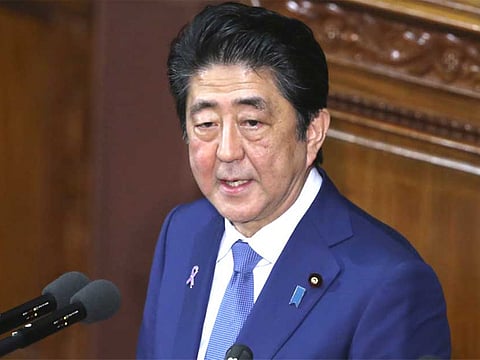The problem with Japan isn’t warmongering — it’s a toothless military
As tensions rise in Asia, Tokyo is going to need to do more — both for itself and for its American friends

This month, United States President Donald Trump threatened China with the prospect of a remilitarised Japan if Beijing did not do more to push North Korea to end its nuclear and missile programmes. Calling Japan a “warrior nation”, Trump noted in an interview that he had warned China “you’re going to have yourself a big problem with Japan pretty soon if you allow this to continue with North Korea”.
But are the Japanese nascent “warriors”? Is the scourge of resurgent militarism about to reinfect the Land of the Rising Sun? The answer to both questions is no. Although moves are afoot in Japan to turn its Self-Defence Forces (SDF) into something approaching a normal military, the idea that Japan risks a return to a “warrior nation” is ludicrous. Indeed, there remains a vast gap between the Japan of today and a Japan that might be able to defend itself.
Grant Newsham says that the biggest problem on the path to military reform is Japan’s “pathological dependence” on the US for its security. Newsham should know. As a colonel in the Marine Corps, he served as a liaison officer to Japan’s Ground SDF. “The Japanese like to say, ‘The Americans are the spear and we’re the shield’,” Newsham said. “Well, in battle, the spear gets bloodied and the shield doesn’t. It’s the Americans who are expected to do the dying on Japan’s behalf.”
Japan’s Prime Minister Shinzo Abe has pushed his country to accept more responsibility for its own defence. In 2015, he backed a set of laws that made it possible for the Self-Defence Forces to come to the aid of its friends. Before that, Japan could be defended by the US, but it could not return the favour. Abe now wants to revise Japan’s pacifist Constitution — not so that Japanese forces can attack other countries, as some alarmists have warned, but rather to give legal standing to the SDF. Most of the Constitution’s Article 9, which prohibits Japan from waging war and obtaining “war potential”, would stay intact. But even this modest change would demand the support of two-thirds of the Japanese parliament, so it’s unclear whether Abe can get it passed.
Even if he does, Japan’s military would still require urgent reform. Right now, its military services — its air force, navy and ground troops — can barely work together, operating instead like warring fiefdoms. They do not even possess radios that can talk to each other. While in Tokyo week before last, Trump urged Japan to buy “a lot of military equipment from the United States”. But as Newsham noted: “You can buy all the F-35s you want, but if every service does what it wants, you’re not going to be able to accomplish anything.”
Backdoor effort
Newsham has been involved in an effort to help Japan develop an amphibious capability, essentially a backdoor effort to force Japan’s ground forces to work with its navy. So far, it has yet to yield results. In fact, the lack of an amphibious capability hampered the military’s ability to save people stranded onshore after the Fukushima earthquake of 2011. “Navy ships could function offshore, but it was impossible to do landings to save people,” Newsham recalled.
Japan’s difficulties with “jointness” have also affected its military alliance with the US. The exceptions are Japan’s navy, which has developed a close relationship with its American counterpart, and US-Japanese cooperation on missile defence. But that’s a short list. After the Fukushima quake, Newsham recalled, US Marines arrived in the region to conduct humanitarian operations. The Japanese army units stationed there had no idea who they were.
Finally, in Japan, there remains little political support for a stronger military. For years, Japan’s media has poked fun at the SDF.
For years, each time a politician in Japan advocated military reform, he or she was lambasted as a warmonger, a fascist or a denier of Japan’s crimes during the Second World War. While this tendency has waned, Japanese voters remain reluctant to devote more resources to protecting their country. Japan currently spends $48 billion (Dh176.54 billion) on defence, but Abe has shelved his vow to push defence expenditures over 1 per cent of gross domestic product (GDP), much less the Nato target of 2 per cent of GDP.
If Japan were located in a peaceable region, its military challenges would not be a cause for concern. But Northeast Asia is one of the most dangerous neighbourhoods on the globe. North Korea routinely fires rockets over Japanese airspace that splash into Japan’s territorial waters. China, which is in the midst of an ambitious programme to reform its military and upgrade its weaponry, claims Japanese territory and routinely violates Japanese airspace and sea lanes.
The alliance between the US and Japan, which was signed in 1952, has lasted longer than any other alliance between two powers since the 1648 Peace of Westphalia. Over the past two decades, successive American administrations have trumpeted its success. Trump was no different. “I don’t think we’ve ever been closer to Japan,” the US president said during his trip to Tokyo. But as tensions rise in Asia, Japan is going to need to do more — both for itself and for its American friends.
— Washington Post
John Pomfret, a former Washington Post bureau chief in Beijing, is the author of The Beautiful Country and the Middle Kingdom: America and China, 1776 to the Present.
Sign up for the Daily Briefing
Get the latest news and updates straight to your inbox


